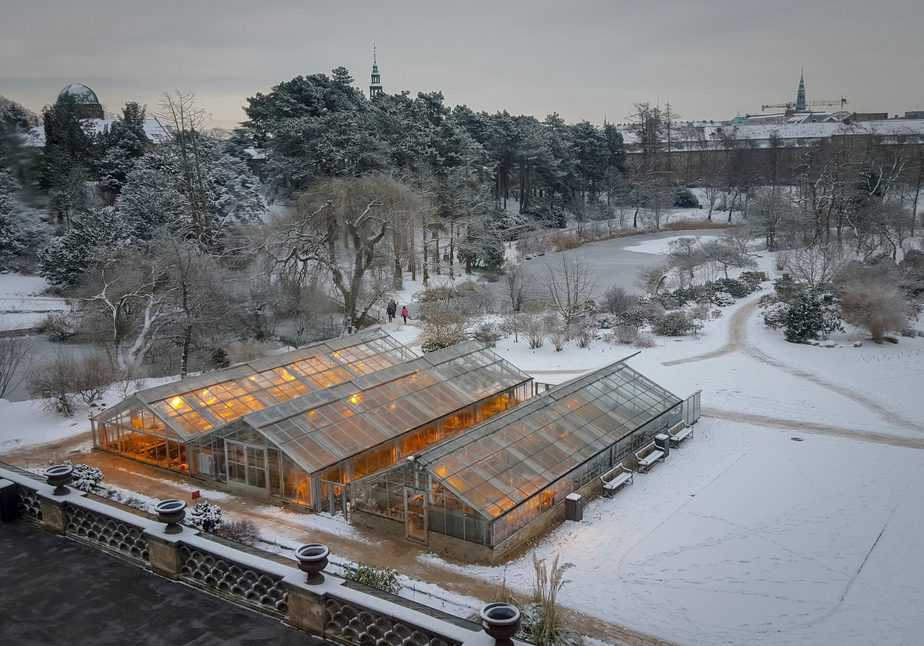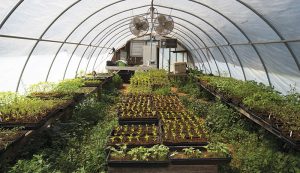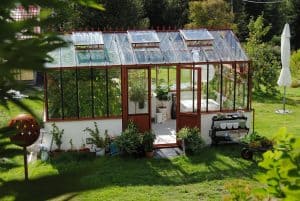Even in an unheated greenhouse, you can grow plenty of vegetables in cold winter climates. Learn how to get your greenhouse ready for winter the right way, so that you can be growing all year long.
Quick Overview:
- Insulate and weather-proof
- Create self-heating systems
- Build for efficiency
Learn Your Greenhouse Climate Zone
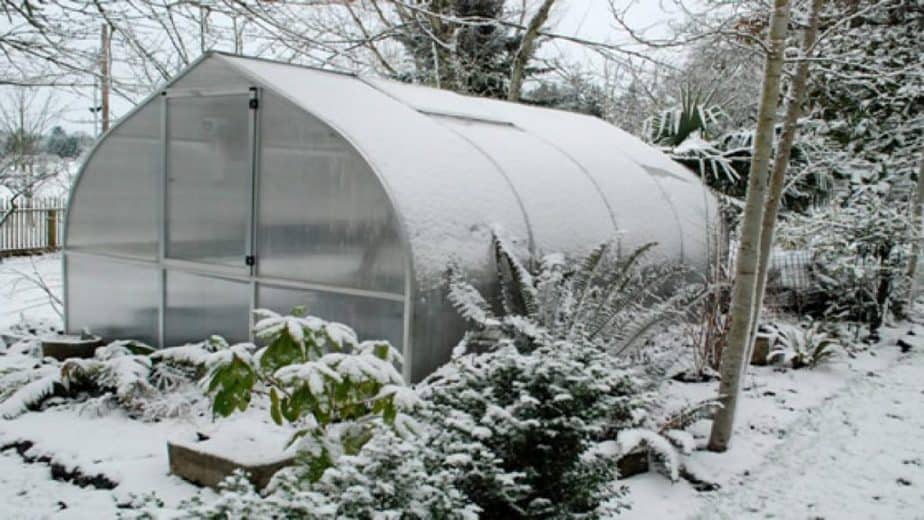
The more you know about your local climate, the better you can work with nature rather than fight against it to grow your most prosperous greenhouse.
Climate Zones indicate the “average” weather in a particular part of the globe. Learning your local zone will allow you to:
- Grow crops that will be happy in your climate
- Plan growing seasons
- Understand what kind of winterizing your greenhouse most needs
There are a few types of Climate Zones; the classification that is most useful for greenhouse growers is the Plant Hardiness Zone. Find yours on the USDA website.
Greenhouse Insulation
Wrap your greenhouse up for winter just like you bundle yourself up in warm clothes! There are many ways to insulate your greenhouse, and most of them are super low-cost and easy to install.
Bubble Wrap
Insulating your greenhouse panes can be just as easy as making a “double-wall” with bubble wrap. Yep, regular ol’ bubble wrap works! But a heavy-duty reflective wrap intended specifically for insulation will keep heat inside the house better.
The advantage of transparent bubble wrap is this: If you forget to remove it during daylight hours, your plants will still get (some) sun. Forget to remove that reflective insulated bubble wrap, and your poor greenhouse will be lacking those essential rays.
You can line the entire greenhouse glazing with bubble wrap, or simply place bubble wrap around plants as needed.
Weather-proofing Tape
Use a water-proof, insulating tape to cover any cracks or gaps that remain in the greenhouse frame and glazing.
Internal Curtains
Use insulating bubble wrap (or another fabric) to create curtains within your greenhouse that separate one big house into smaller “rooms.”
This is a particularly great method if you’re minimizing the number of plants in your greenhouse for winter. Gather all those plants into one section—with lots of sunlight—and hang internal curtains of bubble wrap or fabric to make the plant’s home smaller…and therefore more heat-efficient!
Internal curtains needn’t be fancy or pretty. Simply secure the insulating sheet at the top of the greenhouse and make sure it hangs all the way to the floor, or at least past any plants on risers or shelves.
If you create curtains out of non-transparent material (like felt or wool), be sure to remove them during sunlight hours.
Cover Fabric / Frost Cover
Give your plants the good ole fashioned winter bundle-up treatment.
While wool sweaters do work, you may want to choose a fabric more specifically designed for plants. Plant covers and frost protectors are lightweight, so as not to crush stems and leaves.
Of course, you must be extra sure to remove any fabric that is covering plants during the day so they can soak up the sun’s rays.
Hoop Tunnel
Want the benefits of internal curtains and cover fabric without the trouble of hanging materials from the roof beams? Create a “warm tunnel” for your plants.
A simple hoop structure can be placed anywhere in the greenhouse to be covered by bubble wrap, felt, or another fabric. Hoops/tunnels are super customizable and they’re easy to install/remove as needed.
You can even purchase a hoop tunnel that comes loaded with a fleece insulator all ready to set up over your plants! These are sometimes referred to as “floating blankets.”
Mulching
Just like in your outdoor garden, mulching is a great way to keep plants warm at their roots. Unsurprisingly, this works especially well for root veggies, since they grow under the soil!
Straw is a fantastic natural, low-cost, low-stink insulator—and is also useful if you compost at home. Cover plants’ soil with plenty of straw or wood mulch to help retain heat.
Heating Your Greenhouse Without Electricity

Using non-electrical systems of heating your greenhouse is another way to be even more earth-friendly and sustainable. It’s an open secret that while greenhouses seem like an eco-paradise, they can be energy-consuming monsters, particularly in the winter months.
By creating systems of passive heating, you’re one step closer to a truly sustainable, ecological homestead.
The Self-heating Greenhouse
A self-heating greenhouse uses passive systems to capture, store, and redistribute heat (though the sun is still, in fact, doing the heating).
Read more about heating your greenhouse without electricity here: Keep Your Greenhouse Warm Without Electricity.
Thermal Mass
Thermal mass, also called thermal battery, is a dense, heat-loving material that absorbs, holds, and then redistributes heat. A thermal battery is an amazing way to keep your greenhouse warm, since you’ve already constructed the house to harness the sun’s ray to the best of its ability!
In your greenhouse, you can create a thermal mass/battery several different ways—all relatively inexpensive and easy to build yourself. It’s a brilliant, easy, low-cost way to reduce the carbon footprint of your home greenhouse operations.
The most commonly used materials for thermal batteries are water, stone, concrete, and cob. Here are some examples of how to create a thermal battery.
Greenhouse Heat Sink
A greenhouse heat sink is essential for an underground thermal mass, built right into the floor of the greenhouse. It can store and re-distribute heat with zero electricity.
Ready to build your own heat sink and thermal mass? Read our guide here!
Build It Right
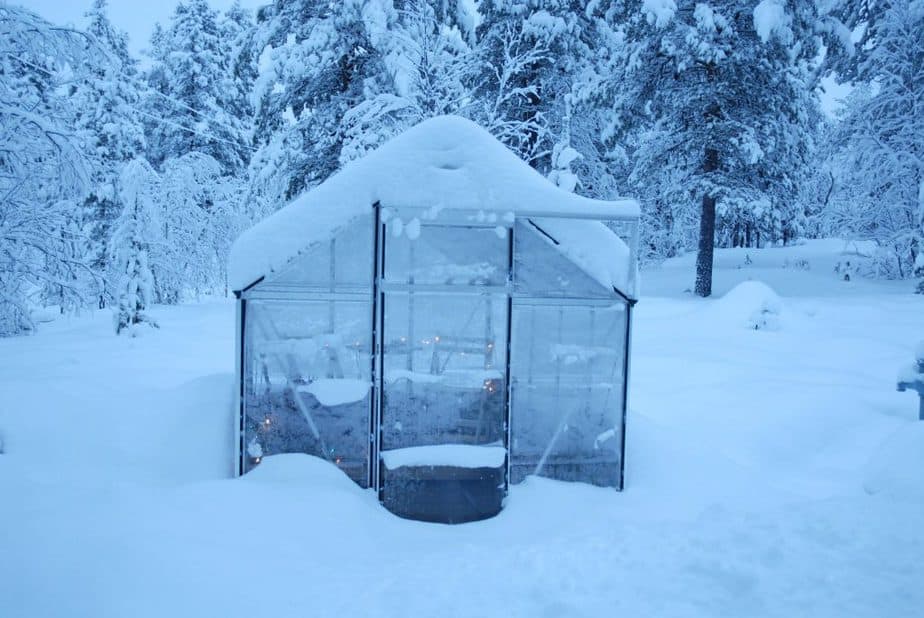
Some of the characteristics that will help your greenhouse withstand a cold winter are built right in. Even before your purchase or build your own greenhouse, think strategically about how to create the most energy-efficient structure for your plants.
Strong Structure
Put attention into the initial plans for your greenhouse. The more secure your greenhouse structure, the better it will retain heat.
Make sure that frame parts fit snuggly to glazing panels, doors and vent are securely installed. Watch for gaps at the base of the frame and consider starting with a foundation for your greenhouse.
Build your greenhouse with heat-loving materials that will help self-insulate. Wood is the best heat-retaining frame material.
Learn more about the essentials of building your own greenhouse in our overview of DIY Greenhouses.
Location & Orientation
Be sure to place your greenhouse in a location that has the most sun exposure possible.
Build your greenhouse facing the sun. I know this can be such a confusing command, because the sun moves across the sky. Plus, what does “facing” the sun mean when you’re talking about a translucent structure with no clear front, back, or sides?
Well, you know that the sun rises in the East and sets in the West, and you know (I hope) that the earth’s axis is on tilt. Remember back to middle school science class, and you’ll remember that, because of this tilt, the sun moves across the sky in an arc, unless you’re directly on the equator.
That means that in the Northern Hemisphere, the sun is always on the Southern side of the sky, and vice versa in the Southern Hemisphere.

“Facing” simply means with one side directly to the South. But you can get even more technical by placing heat-retainin materials (like that thermal mass) and your most sun-hungry plants on the South side of the house.
Paint
Paint a wall that’s opposite or adjacent to your greenhouse in white paint to reflect sunlight and heat the greenhouse. Ideally this would be a wall that faces South as well—see above!
Do A Pre-Winter Check-up
Even if you followed the above rules when building your greenhouse, it’s helpful to check each of these aspects every season—before winter sets in.
Check for gaps and cracks, get frost covers ready, and rearrange your greenhouse if needed. Doing the work before a chill hits the air will save you frozen toes, and it’ll protect your plants from any surprise chilly nights.
And if all else fails, you can buy greenhouse heaters for less money than you’d think!

